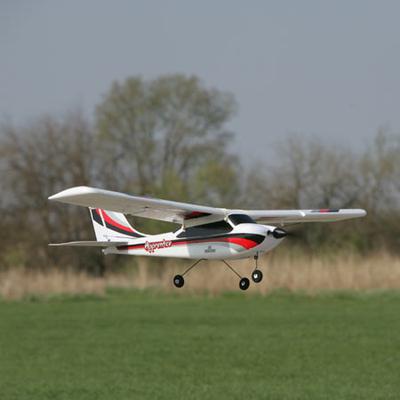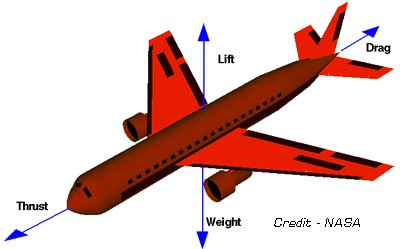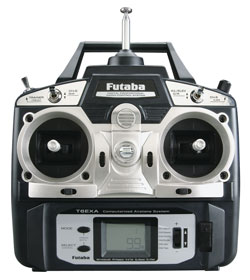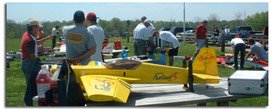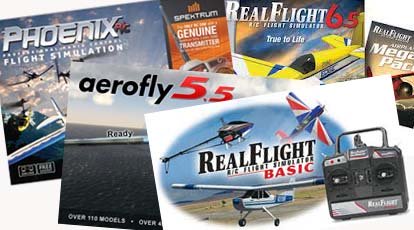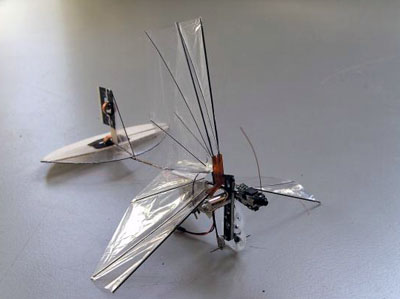The UAV Drone -
Our Enemy's Worse Nightmare...
A UAV Drone is an Unmanned Aerial Vehicle. They have been used as practice targets for anti-aircraft gunnery for decades. Today's military drone's are used extensively for providing aerial reconnaissance for our troops in combat zones.
GPS systems along with other sophisticated navigational equipment are allowing UAV's to be used in high-risk aerial missions without putting a human pilot at risk. In the very near future you will see UAV's being used in just about every application that currently requires manned aircraft.
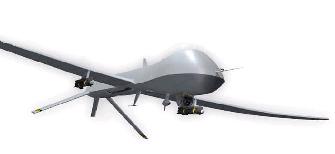 |
Flying Targets - How it all started
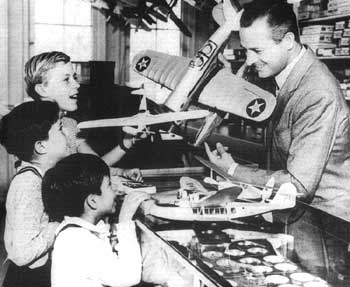
Reginald Denny at his Hobby Shop
Photo : Righter Family Archives
You know whats really cool? The first purpose-built UAV drone used by the US military was built by an old-time RC addict!
After serving with the British Flying Corps in WW1, Reginald Denny came to America and became an actor in Hollywood. Being an RC airplane enthusiast with plenty of money, he opened his own hobby shop.
Back in the day, the only way for military anti-aircraft gunnery to target practice was to shoot at banners or target gliders towed by full-scale aircraft. These full-scale tow planes often ended up with a tail full of bullet holes before landing!
|
Shooting at tow gliders flying in a perfectly straight line was not exactly the practice needed to be proficient at gunning down enemy aircraft... Mr. Denny thought it would be much better practice to shoot at RC airplanes that could fly and maneuver just like enemy combatants. |
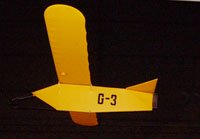 G3 Target Glider |
This would also eliminate the tail repairs on the tow planes. Mr. Denny's hobby shop quickly evolved into the Radio Plane Company which began making radio controlled aerial targets or RCATs.
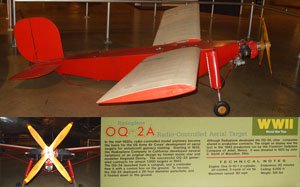
Radioplane OQ-2 UAV Drone
After the tweaking and fine-tuning of four prototypes, the Radio Plane Company began selling thousands of it's RP-5 to both the US ARMY and Navy in 1941.
The US Army called their RP-5 UAV's the US ARMY OQ-2. The US Navy designated its version as the TDD-1, which stands for Target Drone Denny 1.
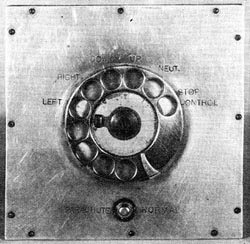 Photo : Model Airplane News, Sep., 1940 |
The above photo was taken at the National Museum of the USAF in Dayton Ohio. Unless told otherwise, it would be difficult to distinguish between this plane and one of our modern day RC airplane trainers! To give you an idea of how primitive this plane really was, take a look at the controller to the left. Yep, those guys actually used a telephone dial to control the airplane |
Present Day UAV Drones
The ability of today's UAV Drone's to fly autonomously is what really sets them apart from the early UAV's.
Autonomous flight is where the UAV is programmed to perform a certain task. Once airborne, the aircraft uses GPS along with other sophisticated navigation and auto control systems to carry out the task independently, without input from a remote operator.
Some tasks are a simple as following GPS navigational points while acquiring photos and live video feeds. UAV's are even being used to carry out high-risk combat missions such as taking out enemy targets.
And just like the Radioplane, some are used to simulate threats by enemy aircraft and missiles.
Unmanned Aerial Targets
Reginald Denny's Radioplane Company later became the Venturi Division of Northrop Grumman, a world leader in the development and production of Unmanned Aerial Targets(UAT's).
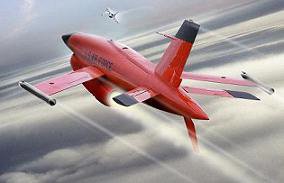
BQM-34 Firebee
A far cry from the original Radioplanes, Northrop Grumman's BQM-34 Firebee is a high performance aerial target system used by militaries around the world!
At nearly the speed of sound, it can fly as low as ten feet from the surface up to elevations of 60,000 ft. Because there is no pilot that could pass out, this bird can make up to 7G turns without even slowing down!
If you can take this bad boy down, the enemy aircraft should be a breeze!
Reconnaissance
Without the limitations of a human pilot, UAV drones's have the ability to stay airborne several hours without landing or refueling. Some can stayed airborne for up to for 40 hours, although around 20 hours is more typical.
Northrop Grumman's RQ-4 Global Hawk UAV drone shown below can survey up to 40,000 square miles a day!
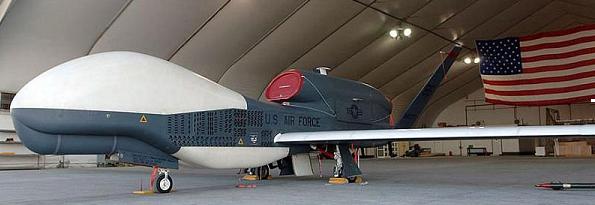
Reconnaissance UAV drones are equipped with just about every type of camera, radar, and sensing equipment imaginable that sends data to the commanders in real-time via satellite and radio links.
It doesn't matter how dark it is or how bad the weather may be, the enemy can't hide! The Global Hawk UAV drone was deployed in Afghanistan to fight the war on terror shortly after 9/11/2001.
During take-off and landing, the Global Hawk is controlled by a local ground station called the Launch and Recover Element (LRE). Once airborne it is controlled via satellite by the Mission Control Element (MCE) located in Beale Air Force Base, California.
Wow, to think that an aircraft cruising the skies over Afghanistan is being controlled by remote pilots in California!
Armed UAV Drone's
General Atomics Aeronautical's RQ-1 Predator UAV was designed as a reconnaissance UAV Drone, much like the Global Hawk.
The R stands for Reconacance and the Q means that it's an unmanned aircraft. When the aircraft was fitted with 2 Hellfire missiles it became the MQ-1 Predator. The M stands for multi-role.
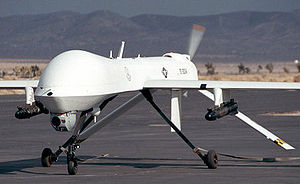
MQ-1 Predator
The Predator UAV is equipped with a laser designator to identify targets for laser guided missiles from other aircraft or from it's own Hellfire missiles!
Since Hellfire missiles are supersonic and the UAV Predator is stealthy, the enemy has little if any warning of a strike. The enemy literally doesn't know what hit them!
The laser guided missiles allow for surgical strikes that minimize civilian casualties. A specific room of a building can be marked for a pinpoint strike!
The Mission Control Element (MCE) for the Predator UAV is located at Creech Air Force Base in Nevada.
How would you like to have a job where you literally spend all day searching for and destroying enemies targets across the map, then return home to a "normal" life with the family each day?
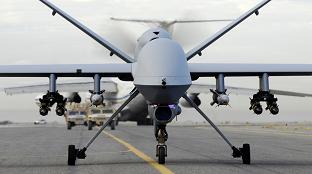
MQ-9 Reaper
The MQ-1 was so successful that a bigger, better, and faster "Hunter-Killer" version was developed.
Carrying up to 15 times more weight and flying 3 times faster than the Predator, the MQ-9 Reaper is the first UAV specifically designed not only for hunting, but also for killing!
It is capable of towing an arsenal of both air-to-air and air-to-ground missiles. The Reaper can identify and remove a threat in a matter of seconds without having to scramble a jet! It is only a matter of time before manned jet fighters are a thing of the past.
Reapers are also being used domestically. An MQ9 can identify a heat signature from a human body from an altitude of 10,000 feet! Unarmed Reapers are now successfully being used to patrol the US Mexico border. The Predator is also being used for search and rescue missions home and abroad.
Mini UAV's
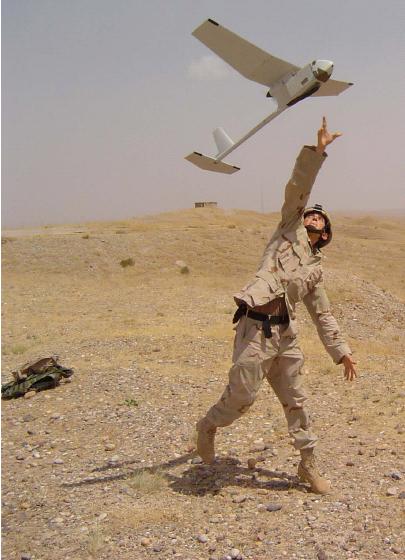
RQ-11 Raven
Small portable UAV's small enough to be carried in a backpack have quickly earned the respect from our troops in Iraq and Afghanistan.
These Mini UAV's expose enemy activity beyond the horizon that otherwise wouldn't be detected.
Military convoys now have their very own capability to observe the enemy as they set up ambushes or plants roadside IED's.
These small UAV's also thwart enemy attacks by providing surveillance around the perimeter of military camps.
Aerovironment's Raven is one of the more popular mini UAV's. Our commanders in the field absolutely love these guys and are buying them by the thousands!
It's hand launched and looks very much like a HobbyZone park flyer. The Raven UAV can be flown manually or autonomously through GPS navigation.
Its battery allows for approximately one hour of flight. The battery can be quickly recharged by plugging it in at the Humvee. It comes with three different cameras to choose from depending on the time of day and weather conditions.
Micro UAV's
Delft University of Technology in the Netherlands is trying to create an autonomous UAV that looks and flies like a dragonfly!
This ornithopter flaps it's wings and flies like a true insect.
Photo: Delphi
he Delfly Micro UAV is the third version of the project. Each version is smaller and quieter than the previous with the current version having a wing span of 15cm and weight of only 3 grams. This only slightly larger than a real dragonfly!
The best part is that this creature carries a camera that broadcasts real-time wireless video! The ultimate goal is for this mechanical flying insect to fly autonomously guided by GPS or other navigational systems. Pretty wild uh?
|
If you think the Delfly Micro UAV is far out, you won't believe what the US government is up to now! The Defense Advanced Research Projects Agency(HI-MEMS) program is developing machine-insect interfaces. These micro-mechanical systems are planted inside insects at the early stages of metamorphosis. Once the larva transforms into an insect, this micro-mechanical chip is completely and naturally imbedded into the insect. Scientists are actually learning how to use these embedded chips to literally hijack the insect and fly it wherever they'd like. |
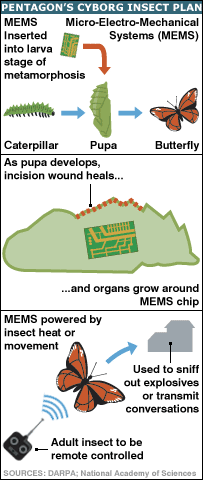 Photo: DARPA |
And that's not the half of it!
The ultimate goal is to control these insects with GPS navigational systems. Each of these "bugs" (pardon the pun) will be equipped with either a video camera, microphone, chemical sniffer, or some other type of sensor.
If this project is successful we can expect to have entire swarms of these "bugs" infiltrating enemy territory providing priceless intel!
Kind of sound like something you'd watch on the Sci-Fi channel doesn't it?
Check out these pages as well...
Home › Drones
Let’s Go Flying! |
|
5 Steps for Successful First Flight! When the RC bug bites, it bites hard! Control yourself my friend! Save yourself much time and money by following these five steps to success! |
